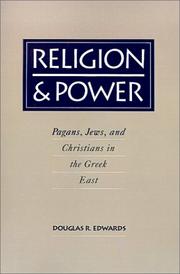| Listing 1 - 3 of 3 |
Sort by
|

ISBN: 128053480X 0195344804 9780195344806 019508263X 9780195082630 0197740774 Year: 1996 Publisher: New York : Oxford University Press,
Abstract | Keywords | Export | Availability | Bookmark
 Loading...
Loading...Choose an application
- Reference Manager
- EndNote
- RefWorks (Direct export to RefWorks)
This book contributes to the small but growing literature on the interaction between religion and power in antiquity. Edwards focusses on the eastern ""Greek"" provinces in the first and second centuries A.D.--the period during which Christianity, Judaism, and numerous other religions and cults exploded across the Roman Empire. His purpose is to show how the local elite classes appropriated and manipulated mythic and religious images and practices to establish and consolidate their social, political, and economic power. Edwards considers both archaeological and literary evidence.
Church history --- Christianity and other religions --- Judaism --- Power (Social sciences) --- Empowerment (Social sciences) --- Political power --- Exchange theory (Sociology) --- Political science --- Social sciences --- Sociology --- Consensus (Social sciences) --- Brotherhood Week --- Apostolic Church --- Christianity --- Church, Apostolic --- Early Christianity --- Early church --- Primitive and early church --- Primitive Christianity --- Fathers of the church --- Great Apostasy (Mormon doctrine) --- Greek. --- Roman. --- Judaism. --- Relations --- Christianity. --- Rome --- Middle East --- Religion. --- 261.2 --- 27 "00/05" --- 261.2 De Kerk en het klassieke heidendom --- De Kerk en het klassieke heidendom --- Jews --- Religions --- Semites --- Syncretism (Christianity) --- Greek religion --- Roman religion --- Relations&delete& --- Kerkgeschiedenis--?"00/05" --- Religion --- History --- Greek religion. --- Roman religion.
Book
ISBN: 1472531507 147421925X 147252358X 9781472531506 9781472523587 9781472524904 9781472534453 9781441100238 9781441123824 9781441131607 9781441165329 9781350127708 9781474250535 9781472587602 9781350039056 9781350039063 9781350039070 9781472587626 1472587626 9781474295741 1474295746 147258760X 1472587626 1350039063 1350039071 1350039055 Year: 2013 Publisher: London Bloomsbury
Abstract | Keywords | Export | Availability | Bookmark
 Loading...
Loading...Choose an application
- Reference Manager
- EndNote
- RefWorks (Direct export to RefWorks)
"The Emergence of the Gulf States covers the history of the Gulf from the 18th century to 1971. Employing a broad perspective, the v. brings together experts in the field to consider the region's political, economic and social development. The contributions address key themes including the impact of early history, religious movements, social structures, identity and language, imperialism, 20th-century economic transformation and relations with the wider Indian Ocean and Arab world. The work as a whole provides a new interpretive approach based on new research coupled with extensive reviews of the relevant literature. It offers a valuable contribution to the knowledge of the area and sets a new standard for the future scholarship and understanding of this vital region."--
Mass media. --- Mass communication --- Media, Mass --- Media, The --- Communication --- Christianity and other religions --- Conversion --- Germanic peoples --- Paganism --- 261.2 --- 266 <363> --- 27 "04/08" --- 293 --- Religious conversion --- Psychology, Religious --- Proselytizing --- 261.2 De Kerk en het klassieke heidendom --- De Kerk en het klassieke heidendom --- Civilization, Pagan --- Heathenism --- Religions --- Germanic --- Christianity&delete& --- History --- Religion --- Missies. Evangelisatie. Zending--Gebieden van de Germanen --- Kerkgeschiedenis--?"04/08" --- Godsdiensten van de Germanen en de Wenden --- Europe --- Church history. --- Church history --- anno 1900-1999 --- Mass media --- Media studies --- Aesthetics --- Philosophy --- Deleuze, Gilles, --- Persian Gulf States --- History. --- Christianity --- Etats du golfe Persique --- Histoire --- Feminism --- International --- Second feminist wave --- Black feminism --- Book --- Activism --- Intersectionality --- Comparative literature
Book
ISBN: 9783110259605 9783110259612 3110259613 1283402467 9781283402460 3110259605 9786613402462 3119165158 Year: 2011 Volume: 184 Publisher: Berlin De Gruyter
Abstract | Keywords | Export | Availability | Bookmark
 Loading...
Loading...Choose an application
- Reference Manager
- EndNote
- RefWorks (Direct export to RefWorks)
After a survey of recent approaches to the study of Paul's use of Scripture, the four main chapters explore the use of Isa. 54:1 in Gal. 4:27, the catena of scriptural texts in 2 Cor. 6:16-18, Hos. 1:10 and 2:23 in Rom. 9:25-26 and Isa. 57:19 in Eph. 2:17.In each case, the ancienwriter seeks to place the letter in its historical context and rhetorical situation, identify the significance of any conflations or modifications that have taken place in the citation process, analyse the citation's function within its immediate context, compare its use by Paul with the various ways in which the text is interpreted and appropriated by other Second Temple writers, and evaluate the main proposals offered as explanations for the riddle posed by the citation. That done, he offers his own account of the hermeneutic at work, based on an analysis of the explicit and implicit hermeneutical pointers through which the letter guides its readers in their appropriation of Scripture.This book compares the hermeneutical approaches of the four letters and draws conclusionsconcerning the interplay of continuity and discontinuity between Scripture and gospel in Paul's letters and the relationship between grace and Gentile inclusion in his theology.
Gentiles in the New Testament --- Bible --- Criticism, interpretation, etc --- Quotations in the New Testament --- Gentiles in the New Testament. --- 227.08 --- 261.2 --- Paulinische theologie --- De Kerk en het klassieke heidendom --- Bible. --- Antico Testamento --- Hebrew Bible --- Hebrew Scriptures --- Kitve-ḳodesh --- Miḳra --- Old Testament --- Palaia Diathēkē --- Pentateuch, Prophets, and Hagiographa --- Sean-Tiomna --- Stary Testament --- Tanakh --- Tawrāt --- Torah, Neviʼim, Ketuvim --- Torah, Neviʼim u-Khetuvim --- Velho Testamento --- Epistles of Paul --- Paul, Epistles of --- Paul Sŏsin --- Pauline epistles --- Risālat al-Qiddīs Būlus al-rasūl al-thāniyah ilá Tīmūthīʼūs --- Criticism, interpretation, etc. --- Quotations in the New Testament. --- 261.2 De Kerk en het klassieke heidendom --- 227.08 Paulinische theologie --- Gentiles. --- Grace. --- Hermeneutics. --- Paul. --- Scripture.
| Listing 1 - 3 of 3 |
Sort by
|

 Search
Search Feedback
Feedback About UniCat
About UniCat  Help
Help News
News